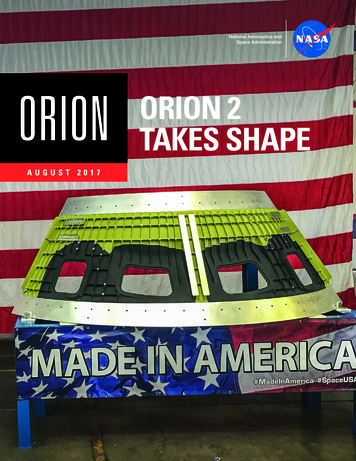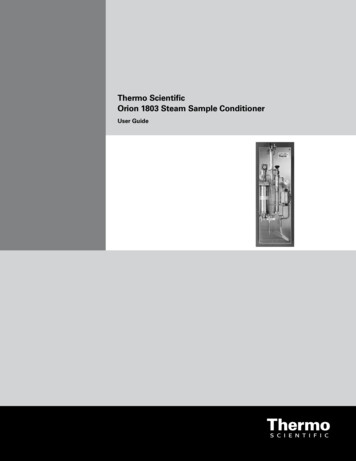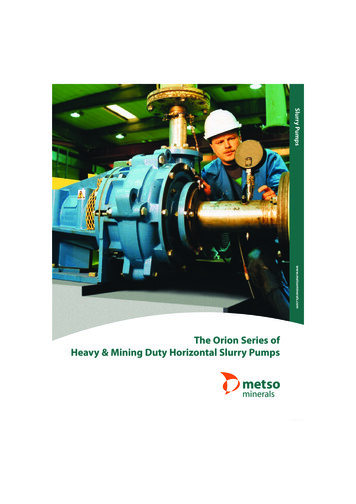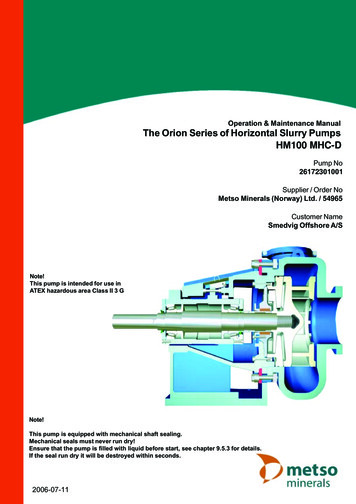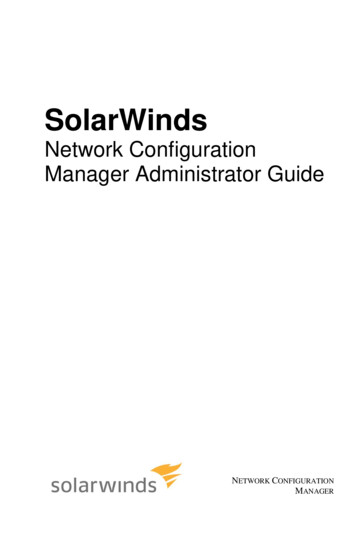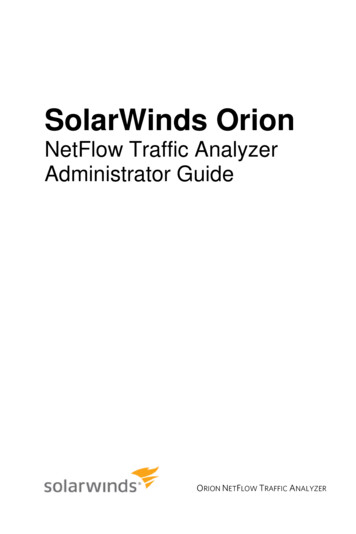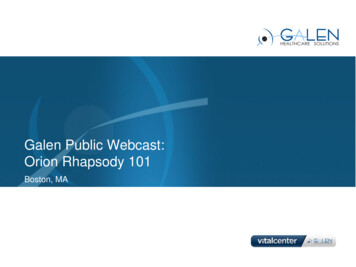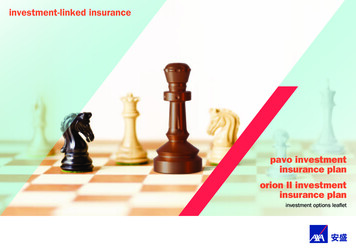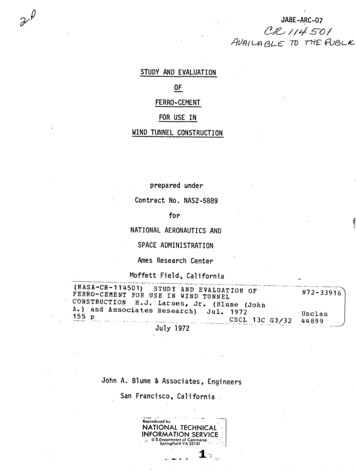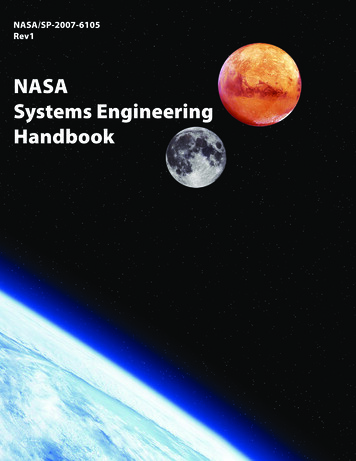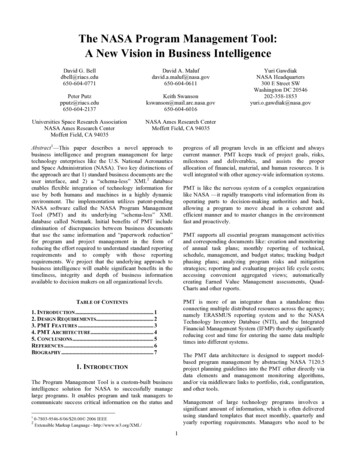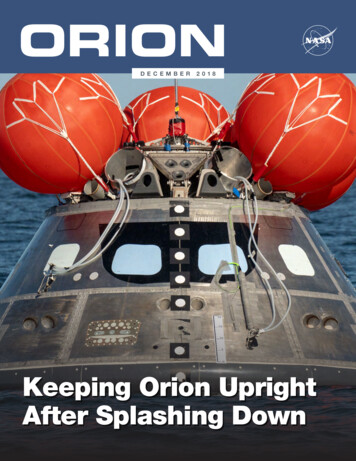
Transcription
ORIOND E C E M B E R2 018Keeping Orion UprightAfter Splashing Down
KEEPING ORION UPRIGHTAFTER SPLASHING DOWNAs NASA progresses toward Exploration Mission-1,the first flight of its Orion spacecraft and Space LaunchSystem rocket, engineers are ensuring every system inthe spacecraft can endure the harsh environment of spacethousands of miles from home and safely return to Earth.A team at NASA has been working to perfect the lastspacecraft system to deploy – the airbags on top of the crewmodule – which will reorient the capsule and keep it uprightand stable after splashdown in the ocean and potentiallythrough rough waves or high winds.Engineers have implemented a series of improvements onthe system to upright the spacecraft since Orion’s successfulflight test in space in 2014. During the flight test, three ofthe system’s five bags did not properly inflate, though thespacecraft remained upright in the water. Improvementsinclude thickening the inner bladder of each round airbag tomake it more durable, changing how the bags are packed,and developing a harder cover.The Orion Crew Module Uprighting System (CMUS)consists of five bags that are packed tightly in containersand stored atop the Orion capsule. After landing, the bagsdeploy from the same area where landing and recoverysystems, such as parachutes and beacons, are stowed.This area also contains protrusions and sharp edges thatcould potentially snag the bags or tethers that keep thebags attached to the spacecraft. The upgrades and testingfurther demonstrate the system can work in these delicateconditions.In early December, the CMUS and Neutral BuoyancyLaboratory teams at Johnson Space Center successfullycompleted two tests off the coast of Galveston, Texas, thatwere instrumental in validating the bags performed asintended. The two test cases covered scenarios where onlyfour of five bags inflated.NASA partnered with the United States Coast Guard and AirForce, and Texas A&M Galveston teams to perform the tests.Next year, the team will test the uprighting system in theocean where rougher wind and wave conditions are more likethose expected when Orion lands approximately 50 miles offthe coast of San Diego after returning from deep space.
TEST FIRING IN UTAH PROVESCREW IS IN SAFE HANDSNorthrop Grumman, along with NASA and Lockheed Martin,successfully performed a ground test firing of the launchabort motor for NASA’s Orion spacecraft’s Launch AbortSystem on December 13 in Promontory, Utah.The 17-foot-long, three-foot-diameter abort motor burnedout in five seconds, about three to four times faster thana typical motor of its size. This high-impulse motor isdesigned to burn most of the propellant within the firstthree seconds to immediately deliver the needed thrustto pull the crew module safely away from danger. Asexpected, the motor reached just under 370,000 poundsof thrust in one eighth of a second—enough thrust to lift66 large SUVs off the ground. If needed during a launchmishap, the crew module would accelerate from zero to400-500 mph in two seconds.This Qualification Module (QM) test, designated QM-2,was a critical milestone toward qualification of the motorthat will safely pull the Orion crew module away fromNASA’s Space Launch System (SLS) rocket in the event ofan emergency on the launch pad or during ascent. QM-2brings Orion one step closer to its first flight atop NASA’sSLS, eventually enabling humans to explore destinationsbeyond low-Earth orbit.Watch a Facebook Live of the event and hear from experts:bit.ly/Dec18QM2
ASCENT ABORT-2REACHES FINAL DESTINATIONThe engineering team at NASA’s Johnson Space Center inHouston completed an Orion milestone by equipping thecrew module for a crucial abort system flight test, AscentAbort-2 (AA-2), and transporting it to the Kennedy SpaceCenter in Florida.The test crew module, complete with its newly attachedseparation ring that serves as its interface to the abort testbooster, was prepped and loaded on a truck for its four-daytrek to Kennedy on Dec. 1. The flight article is protected bymultiple layers of shrink-wrap and tarps to withstand roadhazards and inclement weather.The importance of the AA-2 test is to verify that, in theevent of an emergency during ascent, Orion’s LaunchAbort System (LAS) can fire within milliseconds to pull thecrew module away from the launch vehicle and reorient thespacecraft for a safe landing. A full-stress test of Orion’sLAS is planned for May 2019 from Cape Canaveral AirForce Station.Once at Kennedy, the AA-2 test crew module will first beintegrated with the LAS and tested to ensure functionality.That flight test article will then be transported to the pad tobe stacked atop its test booster in preparation for flight.
ORION TEAMS DESERVINGOF RECOGNITIONSpace Flight Awareness Silver Snoopy awardeesreceiving their awards from Astronaut StephanieWilson in Denver.Representatives of the Orion Thermal Analysis ThermalProtection System team receiving a Space FlightAwareness team award.Orion Program Managers Mark Kirasich (NASA) and MikeHawes (Lockheed Martin) recently visited the LockheedMartin Waterton facility in Littleton, Colorado, to provide aprogram status update to employees. Kirasich also awardedmultiple teams and individuals with Orion Program Managercommendations for their outstanding work on the program.presented to employees who have significantly contributed tothe human space flight program to ensure flight safety andmission success.Prestigious Silver Snoopy honors were awarded by NASAAstronaut Stephanie Wilson to Christine Bland, Linda Cuplin,Jerry Draper, Robert Hixson, Ron Johns, David Krajecki,Sean O’Dell, Karl Yeanoplos, Thomas DiCuirci and JohnLloyd. Earlier in the year, Astronaut Nicole Mann presentedthe award to Mark McCloskey and John Masaveg in aceremony that took place at Michoud Assembly Facility inLouisiana. The Silver Snoopy, which is awarded to fewer thanone percent of the aerospace program workforce annually, isSpace Flight Awareness Honorees receiving awards atNASA’s 60th Anniversary event.Three Space Flight Awareness (SFA) Trailblazer awardswent to Lockheed Martin employees Alex Belt, ChristopherJackson and Andrew Thompson. This award is presented toemployees supporting human space flight during the firstseven years of their career and have demonstrated strongwork ethic and creative, innovative thinking in support ofhuman spaceflight.SFA team awards were presented to the Orion Structural TestArticle Structural Analysis team for their efforts in conductingand completing the structural qualification of the ExplorationMission-1 crew module and the Orion Thermal AnalysisRepresentatives of the Capsule Parachute AssemblySystem team receiving a project commendation fortheir work.
Representatives of the Made in America teamreceiving a Space Flight Awareness team awardfrom Astronaut Randy Bresnik.Representatives from Orion’s supplier Avatarreceiving a Program Manager commendation fortheir work.Thermal Protection System team for designing, developing,testing and certifying the Orion thermal protection systemfor Exploration Mission-1. Astronaut Randy Bresnik alsopresented an SFA award at a ceremony at Kennedy SpaceCenter in Florida to recognize the team members who madeit possible for the Exploration Flight Test-1 crew moduleto be featured on the White House front lawn during theAdministration’s Made in America Product Showcase eventin July. The SFA team award recognizes small groups ofemployees who have demonstrated exemplary teamworkwhile accomplishing a particular task or goal in support ofthe human spaceflight program.exemplary work on Orion including several Lockheed MartinOrion team members who were recognized as SFA Honoreesat NASA’s 60th Anniversary 2018 events in September: DeanColeman, Eric Esposito, Lora Lechago, Frank Middleton,Timothy Norick, Robert Ott, Blake Watters and Mike Wells.Several other team members received SFA awards forCapsule Parachute Assembly System team members wererecognized with a project commendation at the end ofNovember for their outstanding work in the developmentand qualification of Orion’s parachute system for crewedflights. In addition, Orion’s supplier Avatar Machine, located inFountain Valley, California, was presented an Orion ProgramManager commendation for their contribution to the programin preparation for Exploration Mission-2.RADIATIONSHIELDINGPODCASTSMALL STEPS,GIANT LEAPSPODCASTOrion’s need to block radiation as crewmembers travelinto deep space is the focus for Episode 75 of Houston,We Have A Podcast. Matt Lemke, Orion avionics, powerand software deputy manager, discusses how Orion isradiation-hardened so the systems inside can withstandthe harsh environments of space. This includes systemssuch as life support, communications, propulsion,navigation and everything else that is controlled by thecomputer systems inside of Orion, that would malfunctionif too much radiation entered the spacecraft.Listen here: go.nasa.gov/2SWilyrIn this first episode of Small Steps, Giant Leaps, Dr. GregHolt, navigation lead for the Orion spacecraft, discusseshow the vehicle finds its way through deep space andcommunicates with Earth along the way. Listen in to getan insider’s view on how we’ll track Orion, gather realtime diagnostics, and stay in communication with thespacecraft and its crew as they journey into deep space.Listen here: go.nasa.gov/2ST1UTi
4TH ANNUAL SPACECOMSHOWCASES ENTREPRENEURSLockheed Martin and NASA Orion team memberssupported the 4th annual SpaceCom Expo at George R.Brown Convention Center in Houston Nov. 27-28. The eventbrought together people from a wide variety of industriesfrom across the country and around the globe with morethan 2,200 participants representing 450 organizations from39 different countries, including leadership from aerospaceindustry and space agencies such as NASA, India’s AntrixCorporation, the Australian Space Agency and the ItalianSpace Agency. Additional highlights included the NationalSpace Council’s Users Advisory Group session and theGlobal Spaceport Summit with 19 spaceports participating.startup companies that exhibited new technologies in theEntrepreneur Pavilion. Jim Crocker, vice chair of the SpaceStudies Board of the National Academies of Sciences,Engineering, and Medicine and Lockheed Martin SpaceVP & GM (retired), served as a judge for the semi-final andfinalist rounds of the Entrepreneur Challenge competitionand presented the top prize for the most innovativepresentation. Houston-based Lazarus 3D Inc. won thecompetition for their utilization of cutting-edge 3D printingtechnologies that provide the best medical training modelsfor medical professionals to transform surgery training onEarth and in space.Lockheed Martin sponsored the Entrepreneur Summitthis year, a new addition to SpaceCom featuring 24For more information, visit: spacecomexpo.com
SUPPLIER SPOTLIGHTWREN INDUSTRIESMike Sneddon, president of Wren Industries, shows Art Maples from NASA a wiring plate which will be installed onOrion’s EM-1 spacecraft.Wren Industries provides a much-needed capability thathelps technicians respond and react quickly while an Orionspacecraft is being assembled in the Operations & CheckoutBuilding at Kennedy Space Center. Wren Industries hasprovided a variety of parts from full 5-axis machine componentsto precision shims. Orion continues to break barriers withhuman capable spacecrafts, but it still uses some of the sametechniques originally developed during the Apollo program.Every now and again you need carefully crafted shims built to the same exacting specifications as the structuralcomponents themselves - to ensure a proper fit andalignment. Wren provides these shims which allow criticalcomponents to fit in their final locations properly as part ofthe Exploration Mission-1 and 2 crew modules as well asthe structural test articles. The Orion Program is their firstopportunity to support NASA.FOLLOW THE PROGRESS OFNASA’S NEW SPACECRAFTFOR HUMAN EXPLORATION:JANUARY 2019Twitter.Twitter.com/NASA OrionO&C Team Rocks Around the ClockFacebook. Facebook.com/NASAOrionAA-2 Flight Motor Arrives in FloridaFlickr. Flickr.com/NASAOrionTumblr. NASAOrion.tumblr.com
flights. In addition, Orion’s supplier Avatar Machine, located in Fountain Valley, California, was presented an Orion Program . and software deputy manager, discusses how Orion is . technologies that provide the best medical training models for medica
